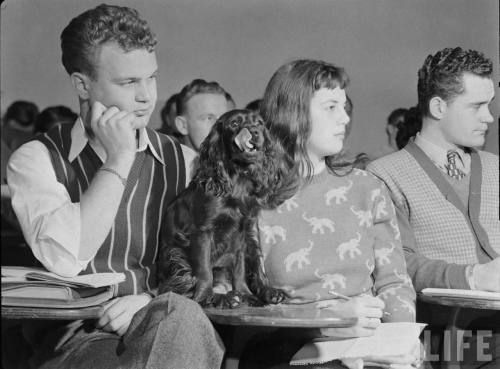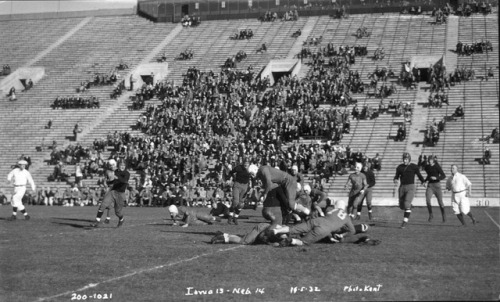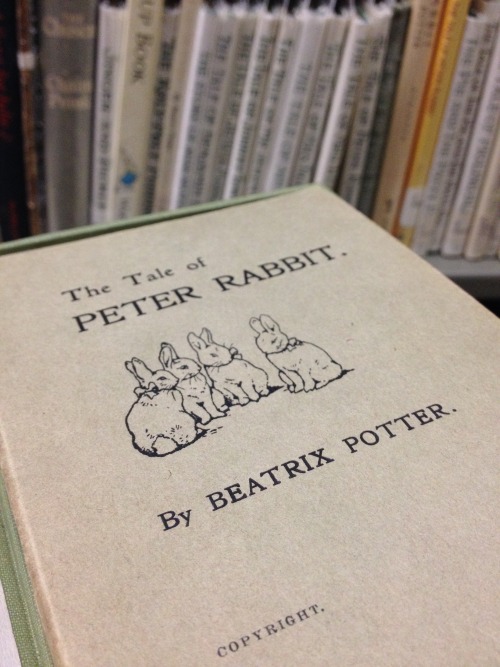#university of iowa
Iowa-Nebraka football game at Iowa Stadium, The University of Iowa, November 5, 1932
Photographer: Kent, Frederick W.
Nebraska won 14-13. Iowa football games were played at Iowa Field until Iowa Stadium opened in 1929. Iowa Stadium was renamed Kinnick Stadium in honor of Heisman Trophy winner Nile Clarke Kinnick in 1972.
Source: http://digital.lib.uiowa.edu/cdm/ref/collection/ictcs/id/6185
Post link






Guest Post from John Martin Rare Book Room
At the Hardin Library for the Health Sciences
MORGAGNI, GIOVANNI BATTISTA (1682-1771). Opuscula miscellanea quorum non pauca nunc primum prodeunt, tres in partes divisa [Miscellaneous works, some of which are new, divided into three parts]. Printed by Giovanni Antonio Remondini at Remondiniana, Bassano del Grappa, 1763. Three volumes bound together. 39 cm tall.
This month we highlight a book currently receiving treatment from the UI Libraries Conservation and Collections Care. Collections Conservator, Beth Stone, is working to clean and stabilize one of our books from Giovanni Battista Morgagni (1682-1771).
Morgagni was an 18th-century Italian anatomist and physician. He is referred to as the “father” of modern pathologic anatomy. He stressed connecting the symptoms observed in the sick to the findings from their dissection. Symptoms, he felt, were “the cry of the suffering organs.” His work helped dispel the longstanding notion that most diseases were scattered throughout the body. Instead, he was able to demonstrate that they emerge from specific organs and tissues.
During his very long life, Morgagni was a prodigious worker and prolific writer. His three-volume Adversaria Anatomica (1706-1717) put him on the map. His most monumental work, De sedibus, et causis morborum per anatomen indagatis libri quinque, was published in 1761 and made him a legend among anatomists. Vast in scope, it is one of the most fundamentally important works in the history of medicine.
The book this month, however, is Morgagni's Opuscula miscellanea quorum non pauca nunc primum prodeunt, tres in partes divisa [Miscellaneous works, some of which are new, divided into three parts]. As stated in the title, this is a collection of writings on a variety of subjects, including letters to Giovanni Lancisi, an Italian physician, discussing how Cleopatra died.
Morgagni’s scholarly ability was apparent at an early age. At sixteen he was a pupil of Antonio Maria Valsalva at Bologna, and there he received the stimulus to devote his life to pathology. While pursuing postgraduate studies, he worked with Giovanni Santorini performing dissections. (Giovanni was clearly a very popular name at this time!)
By 1715 he took the chair of anatomy at Padua, a seat which he held with utmost distinction for many years. He was a brilliant and tireless investigator and, in addition to his work in medicine and anatomy, was a student of the classics and an archaeologist of repute.
Over his long career at the University of Padua, he taught thousands of students from dozens of countries. His teaching emphasized empirical data, direct observation, and experimentation.
Among several other structures, his name is most widely connected with the “Columns of Morgagni,” the fine, vertical folds of the anal canal.
As mentioned, if he was not teaching or dissecting, Morgagni was writing. Opuscula miscellanea shows his range and diverse interests. Along with discussing Cleopatra’s cause of death, it includes a biography of his mentor, Valsalva, a tract on gallstones, and a few more on legal issues.
Opuscula miscellanea has a lovely, soft paper cover. The cover shows the effects of age, use, and exposure to the environment, with scuffs, stains, and an overall darkening. Do not let that fool you, though, as this is still an effective binding. With a new housing from Conservation, Opuscula miscellanea will be around for a very long time.
Go here to read about Beth’s treatment for Opuscula miscellanea and more.
The annual JMRBR open house is April 20, from 4-7 pm. This is our first in-person event in quite some time and we’d love to see you there!
#VoicesfromtheStacks

Slater of Iowa&Fred “Duke” Slater



Calling all the American football fans!
Slater of Iowa by James A. Peterson is a biographical story on Frederick Wayman “Duke” Slater, the first Black All-American player for the University of Iowa, and the first Black lineman in the NFL. Slater is well known for his play with the Iowa Hawkeyes in 1921 where he helped win 10-7 against Notre Dame, breaking Notre Dame’s 20 win game streak!
The book is a short but comprehensive read on the history of Duke Slater. The biography recounts in detail his relationship with football: from childhood to his career on the University of Iowa’s Hawkeye’s football team. It also includes accounts of others he’s played with, some milestones in his early football career (including the time he started wearing a helmet), details of his games at Iowa, his dad’s involvement, and his career at Iowa in general. Slater of Iowa is a quick and exciting read, and as you can see by the images above, Peterson, the author, is good at describing the scene of the games, and giving them life.
The University Archives’ vertical file on Slater details more than just his football career at Iowa! Several clippings talk of his career as a Judge in Chicago, along with Slater Hall, his football accomplishments outside of Iowa, and more. A few snapshots of his file are shown below:



Learning about Slater is definitely worth a visit to Special Collections & Archives!
-Matrice Y, Special Collections, Olson Graduate Assistant









#VoicesFromTheStacks
Bust Zine
What began as a black-and-white Xeroxed feminist fanzine in 1993, Bust evolved into a magazine that continues to have a cult following. Founded by Debbie Stoller, Marcelle Karp, and Laurie Henzel, who asked their friends to “write stories they didn’t see reflected in the media about their lives,” the magazine publishes four times a year and is a respected feminist space for writers. They balance humor, social or personal topics of interest, and fun.
Our copies of Bust are held in the Erik Farseth Zine Collection, but we are also home to many interesting zine collections, many of them centering women, that run the gamut from affordable early DIY efforts to more expensive publications.
Whether you’re interested in some of the cool women featured on the cover, or you’re simply a person “with something to get off your chest,” you will find something interesting inBust and all of the great zines we have here at Special Collections & Archives.
–Rachel M-H, Special Collections Olson Graduate Assistant






#VoicesfromtheStacks
The Star Gazer: Planisphere PoetryandLunar Volvelle, both by Monica Ong
This week we are looking at two works by book artist Monica Ong. Ong is a 2nd generation Chinese-Filipino American who was born and raised in Chicago, IL.
The Star Gazer: Planisphere Poetry depicts the Chinese night sky from the northern hemisphere. It is based on the Soochow Astronomical Chart of 1193. This star chart holds small phrases of beautiful prose weaved around constellational lines to form the poetry within this piece. Taken directly from her Proxima Vera site, there are a few steps to read this structured poem:
“To view the stars, turn the disc to align the desired date with the hour of night. Face south and hold the planisphere overhead with the corner marked North facing north. The map will reveal a celestial poem that awaits you among the asterisms. Let the eyes wander and read aloud to someone dear.”
Ong not only wrote the poetry for this piece, but she also designed the art and construction of the book, including its typesetting. She used gold foil stamping, die cutting, and had it put together by a letterpress studio in Syracuse, New York.
We have another one of her items as well, Lunar Volvelle, which can be interpreted in any way you wish and viewed in our reading room!
Happy gazing. ⭐
-Matrice Y, Special Collections Jr. Olson Graduate Assistant






Guest Post from John Martin Rare Book Room
At Hardin Library for the Health Sciences
Early Spanish anatomy book from Manuel de Porras.
DE PORRAS, MANUEL. Anatomia Galenico-moderna / compuesta por el doctor Don Manuel de Porras, cirujano de su magestad, y de los Reales Hospitales de la Corte, y Examinador del Real Protomedicato [Modern Galenic anatomy: composed by Dr. Don Manuel de Porras, surgeon of his majesty, and of the Royal Hospitals of the Court, and Examiner of the Royal College of Physicians]. Printed at the Imprenta de Musica by Bernardo Peralta in 1716.
De Porras was a surgeon to King Felipe V (the first of the French Bourbon dynasty to lead Spain) and an instructor of surgery and anatomy. Felipe instituted many reforms, mostly to reshape the monarchy and consolidate power, but also to improve Spanish science and medicine. This included the importation of ideas and practitioners from universities throughout Europe. De Porras leveraged this knowledge transfer to create his most well-known book, Anatomia Galenico-moderna, an anatomy book for surgeons.
Criticized as, amongst other things, being “unoriginal,” de Porras nevertheless was the first to synthesize ancient thinking on anatomy with the latest from the European masters, and write in his native Spanish - not the traditional, but less accessible, Latin or Greek. Anatomia… would increase the accessibility of this knowledge and inspire new Spanish anatomical works throughout the 18th century.
Anatomia… is the first Spanish anatomy book published in the 18th century. It also represents a concerted effort on the part of the new king and the doctors and surgeons of Spain to create medical works in Spanish. This was meant to make these texts more accessible and to burnish the reputation of Spanish medicine as an equal to their European peers.
De Porras’s work is also unique in the number of prefaces included in the 1716 printing. The majority of the seven prefaces, all by different authors, spend a considerable effort to defend Spanish medical science from past European critics. They offer Anatomia…as proof that Spain was no longer a scientific and medical backwater.
Regardless, the book was not the most well-received. The book’s most vocal critic was Martin Martínez, one of king Felipe’s physicians and also an anatomist. Martínez took a great interest in the improvement of medical education and played a major role in establishing the anatomical amphitheater in the general hospital at Madrid. His main complaint about de Porra’s work was the nature of the language and vocabulary de Porras employed, given its intended audience - surgeons. He felt the book adequate enough for learned physicians, but too confusing for the more brutal and straightforward work of the surgeon.
This complaint highlights the contentious relationship between physicians and surgeons, two very different professions at the time. Among Martínez’s several works is his own anatomy book, Anatomia completa del hombre [Complete anatomy of man], which was first published in Madrid in 1728 (we have his second edition, printed in 1745). A comprehensive work, it became a popular text with at least six editions.
Anatomia… contains several engraved illustrations by Matías de Irala Yuso, who also contributed illustrations to Martínez’s Anatomia complete del hombre. The illustrations are mostly anatomical, but he does include an engraving of de Porras and another of St. Francis Xavier receiving medical treatment.
-Curator Damien Ihrig
Hall of Chemistry and Pharmacy, The University of Iowa, March 1930
Creator: Kent, Frederick Wallace
Frederick W. Kent Collection of Photographs, 1866-2000
Post link
A shot from the University of Iowa Special Collections stacks of a privately printed Tale of Peter Rabbit.
Post link









